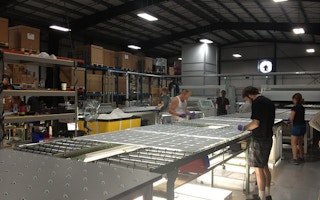In 2011, solar power reached a tipping point. This was the year when the solar industry had saved more greenhouse gases than it emitted.
This is the best estimate of a new paper published today in the journal Nature Communications, which addresses questions around the sustainability of solar panels by comparing the amount of CO2 emitted during production to the amount saved once in use.
Production emissions
Solar power capacity has grown quickly globally over the past 40 years. Cumulative capacity grew from less than one megawatt (MW) in 1975 to around 180 gigawatts (GW) by the end of 2014, the study says. That is an increase of around 45 per cent year-on-year.
This growth rate is celebrated as a sign of a thriving industry and as a boon in the fight against climate change. This is because solar panels generate carbon-free, renewable power.
However, producing the panels requires energy. Since this energy largely comes from fossil fuels, greenhouse gases are emitted during panel production.
Individual solar panels displace more dirty energy over their lifetime than was consumed during their production. But for the industry as a whole, rapid growth means initial production emissions may have outweighed the savings from using solar instead of coal or gas.
It is only when these savings start to outweigh CO2 released during production that the solar industry contributes to mitigating climate change. The paper published today investigates when this break-even point occurs.
“
Since the payback times are decreasing over time, we have now reached the point that even at this strong growth, the total installed PV capacity is a net producer of energy and a net GHG sink.
Atse Louwen, researcher, Utrecht University
Method
To work out the extent of this issue, the study looked at various elements of the solar industry over a period 40 years, from 1975 to 2015, including its growth, improvements in efficiency, and cumulative energy demand and greenhouse gas emissions.
Measuring cumulative installed capacity meant creating a dataset that is an “aggregate of more and less accurate data” from various suppliers and countries, the study says.
The greenhouse gas emissions produced and displaced by the solar industry depends on where the solar panels are made and used — some countries have more polluting power grids than others, depending on the source of electricity. For instance, countries that source a larger proportion of their power from coal will have a more carbon-intensive grid.
To take this into account, the researchers used the average carbon intensity of the grid in producing countries to measure emissions, and the average of all grids to measure the emissions displaced.
This could lead to a conservative result, the study admits. In real life, new solar capacity is more likely to replace older, fossil fueled plants as they are decommissioned, which would mainly use coal.
The study specifically looked at two types of solar panel — monocrystalline- and polycrystalline-based systems — as these account for 90 per cent of installed capacity.
Findings
The scientists found that, from 1975 up to 2011, solar panels were actually a source of greenhouse gases globally. The emissions avoided by existing solar panels were insufficient to offset the amount of emissions that had ever been produced by the rapid production of new solar panels.
But in 2011, this flipped. Instead of being a net source of emissions, the solar industry started avoiding more emissions than it emitted, providing a net climate benefit.
Atse Louwen, a researcher at Utrecht University and co-author of the study, tells Carbon Brief: “What we show is that although current rates of installed PV [photovoltaic] capacity growth are quite high, the industry as a whole is a net negative carbon emitter and will be so from now on, if growth rates do not increase drastically.”
This “most probably” means that any progress in limiting global emissions growth before 2011 was not a result of the increase in solar, co-author Wilfried van Sark, associate professor at Utrecht University, tells Carbon Brief.
One element that allowed the tipping point to occur is the increasing efficiency of solar panel production, the study says.
For every doubling of installed solar capacity, there is a decrease in greenhouse gas footprint of 17 per cent (polycrystalline) and 24 per cent (monocrystalline). This means that individual solar panels will take less time to displace the emissions from their production. Louwen adds: “Since the payback times are decreasing over time, we have now reached the point that even at this strong growth, the total installed PV capacity is a net producer of energy and a net GHG sink.”
The 2011 date depends on “realistic” assumptions about the performance of solar panels and also where production will take place over time — each country’s energy mix has a different carbon intensity and will, therefore, affect the footprint of solar panel production.
In a worst-case scenario for solar performance, the break-even point occurs in 2018. In a best-case scenario, it could have occurred as early as 2001.
This story was published with permission from Carbon Brief. Read the full story.

















